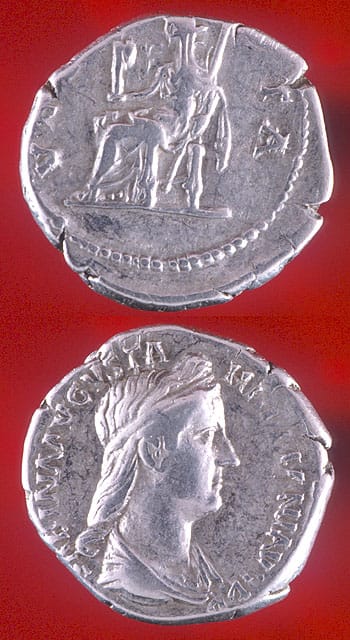Silver Denarius of Empress Sabina, 120 CE - 136 CE
Silver
C.0691
Obverse: Diademed and Draped Bust of the Empress Facing Righ Reverse: Vesta, Seated to the Left, Holding a Palladium and a Sceptr Vibia Sabina’s parents died when she was young...
Obverse: Diademed and Draped Bust of the Empress Facing Righ
Reverse: Vesta, Seated to the Left, Holding a Palladium and a Sceptr
Vibia Sabina’s parents died when she was young and she was raised by her uncle, the Emperor Trajan, whose fondness for his nephew Hadrian brought about his marriage to Sabina in 100 AD when she was 16. Like the other two women of the Nervo-Trajanic dynasty, she had no children of her own and instead raised two adoptees named Lucius Aelius and Antoninus Pius. She is said to have aborted at least one child, stating that any child of Hadrian’s would “harm the human race”; this was, unfortunately, to be the general tone of their marriage.
She was said to have been exceptionally strong minded and somewhat difficult for Hadrian to control. She also had an affair with one of Hadrian’s slave boys in the 120’s. This said, she was dutiful towards her husband and nation. Her devotion was awarded with the title of Augusta in 128 AD. The marriage endured to her death – arguably by poisoning at Hadrian’s hand, although this is unlikely – in 136/7.
Representations of Sabina follow the general remit of honorific coins produced to commemorate the spouses of famous emperors. Statues show her as being a fairly plain, solidly matriarchal woman, but with a finely moderated face that could be said to reflect the unfortunate circumstances of her time when women were essentially traded like goods. At this time, Roman coiffures were at their most flamboyant, and Sabina seems to have been devoted to her appearance judging from the complexity of her hair in the current case. The triple-tiered look which sometimes appears is known as stephane – tiaras – descended from the Greek word for crown (stephanos).
Vesta was the goddess of hearth, home and family, and was represented by the eternal flame kept burning in Roman and tended by the Vestal Virgins. The importance of “family values” to the Imperial Roman war machine, and indeed society in general, cannot be overstated, and as imperial possessions overseas continued to grow, so too did the need to reinforce borders with home-grown Roman soldiers, and to remind those in the provinces of their sacred duty. The association of Sabina with Vesta signifies all of this, although it is in a sense cruelly ironic given her personally unhappy family life.
Reverse: Vesta, Seated to the Left, Holding a Palladium and a Sceptr
Vibia Sabina’s parents died when she was young and she was raised by her uncle, the Emperor Trajan, whose fondness for his nephew Hadrian brought about his marriage to Sabina in 100 AD when she was 16. Like the other two women of the Nervo-Trajanic dynasty, she had no children of her own and instead raised two adoptees named Lucius Aelius and Antoninus Pius. She is said to have aborted at least one child, stating that any child of Hadrian’s would “harm the human race”; this was, unfortunately, to be the general tone of their marriage.
She was said to have been exceptionally strong minded and somewhat difficult for Hadrian to control. She also had an affair with one of Hadrian’s slave boys in the 120’s. This said, she was dutiful towards her husband and nation. Her devotion was awarded with the title of Augusta in 128 AD. The marriage endured to her death – arguably by poisoning at Hadrian’s hand, although this is unlikely – in 136/7.
Representations of Sabina follow the general remit of honorific coins produced to commemorate the spouses of famous emperors. Statues show her as being a fairly plain, solidly matriarchal woman, but with a finely moderated face that could be said to reflect the unfortunate circumstances of her time when women were essentially traded like goods. At this time, Roman coiffures were at their most flamboyant, and Sabina seems to have been devoted to her appearance judging from the complexity of her hair in the current case. The triple-tiered look which sometimes appears is known as stephane – tiaras – descended from the Greek word for crown (stephanos).
Vesta was the goddess of hearth, home and family, and was represented by the eternal flame kept burning in Roman and tended by the Vestal Virgins. The importance of “family values” to the Imperial Roman war machine, and indeed society in general, cannot be overstated, and as imperial possessions overseas continued to grow, so too did the need to reinforce borders with home-grown Roman soldiers, and to remind those in the provinces of their sacred duty. The association of Sabina with Vesta signifies all of this, although it is in a sense cruelly ironic given her personally unhappy family life.
